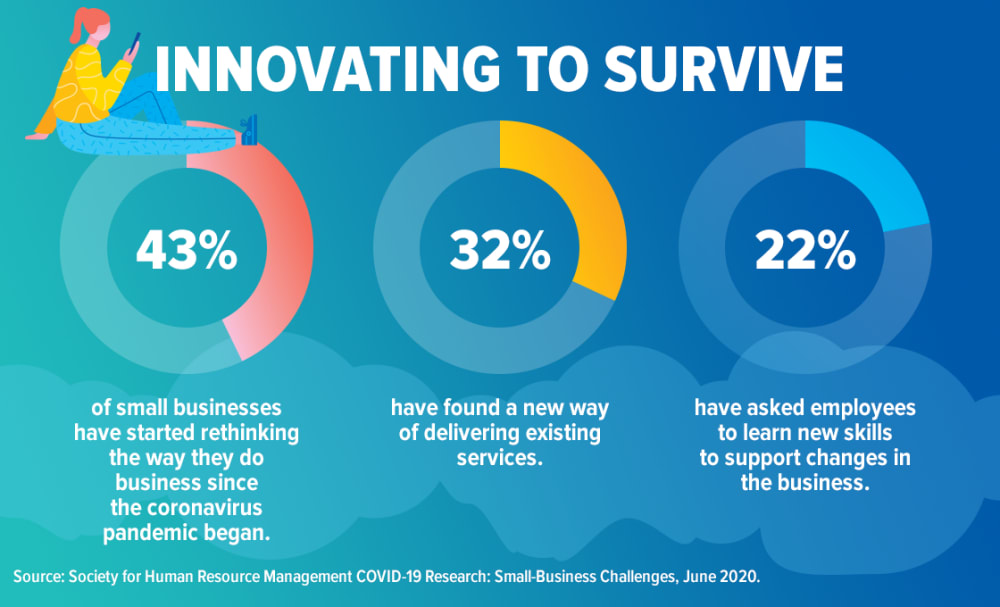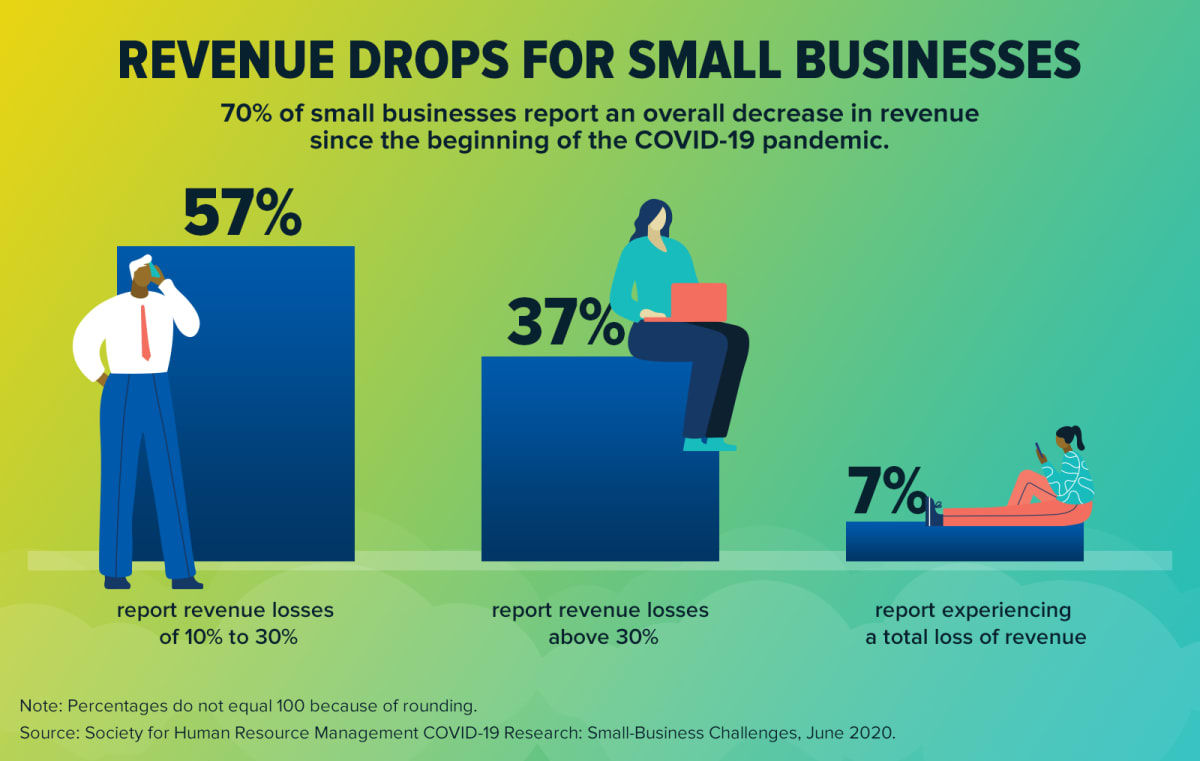 Small Businesses Get Creative to Survive During the Pandemic
Small Businesses Get Creative to Survive During the Pandemic
Moriarty’s Gem Art, a family-owned jewelry business located along the courthouse square on Main Street in Crown Point, Ind., was forced to shutter its retail store in March when the coronavirus pandemic prompted a city mandate requiring all nonessential businesses to close.
“But when we closed our doors, we had to come up with different strategies to keep business going and engage with our customers,” says Jeff Moriarty, marketing manager and oldest son of co-owners Steve and Nancy Moriarty. “We did know we would open up again sometime, but we didn’t want to just wait, which is why we did everything we could to continue to bring in sales.”
Millions of small-business owners across the country faced a similar challenge as the coronavirus shut down much of the U.S. economy and consumers stayed home to slow the spread of the virus. To stay afloat, owners adapted on the fly and found creative ways to change their operating models.
Still, many small businesses have failed. Others have survived and plan to use innovations adopted during the pandemic to drive revenue and generate new opportunities as the economy recovers, but the impact on millions of employees nationally is uncertain.

At Moriarty’s Gem Art, innovation meant creating a livestreamed gem show. It had been on the to-do list for 2019, but the staff of seven, which includes Moriarty family members, did not have time to produce a show while running the retail outlet, founded in 1975.
COVID-19 changed that.
“About two weeks into the crisis, we started doing livestreams through YouTube using YouTube Studio software,” Jeff Moriarty says.
The company advertised the livestreams through its website, by e-mail and via social media. More than 1,000 people now watch the two-hour show that airs every other Wednesday. In addition to selling gems online, during the show, the Moriartys highlight a variety of stones from the company’s inventory, like an Ethiopian opal similar to the one featured in the acclaimed 2019 movie “Uncut Gems,” starring Adam Sandler.
Launched in April, the shows are a variation of the prerecorded spots the company did for several years featuring Steve Moriarty as he cut, faceted and polished gems and talked about his travels to exotic locales, such as the mines of Tanzania and Madagascar, where the company obtains many of its stones. Pandemic travel bans have caused him to cancel his global trips and concentrate on sources closer to home, such as Oregon, which is known for its sunstone.
Livestreaming not only has helped the company stay connected with customers, Jeff Moriarty says, “it has generated a ton of sales.”
Moriarty Gem Art realized $12,000 in revenue from its July 8 show. Another show during the pandemic resulted in a $20,000 sale of a Tanzanite stone to a customer in Singapore. Many of the company’s customers are collectors who prefer uncut gems they can have customized.
Livestreaming has allowed the business to connect with current customers and attract new ones.
“We always wanted to do [livestreaming] in the past,” Moriarty says. “With more free time, we were able to put it together. It definitely did bring in a good amount of revenue for us.”
He attributed his increased sales in part to the closure of many jewelry stores. People continue to get engaged and married, and they want rings and other jewelry to mark those important occasions, he notes.
The Moriartys re-opened their store in July, two weeks after Crown Point rolled back its citywide quarantine.
“We’re a small business, and the [federal] recovery funds can keep you going for only so long,” Jeff Moriarty says. “The majority of our sales is through our brick-and-mortar store.” However, livestreaming “has been so successful that we have continued it … and don’t look to end it.”
CREATING NEW OPPORTUNITIES
The number of active business owners in the U.S. fell by 3.3 million—or 22 percent—from February to April 2020, the National Bureau of Economic Research (NBER) reported in June. That was the largest decline on record, and it affected nearly all industries.
Minority-owned companies were especially hard hit. Black-owned enterprises experienced a 41 percent drop in trade, Latino-owned businesses saw a 32 percent decline, and Asian-owned businesses saw a 26 percent decrease.
Additionally, immigrant business owners saw a 36 percent loss in business, and women-owned businesses experienced a 25 percent drop in trade, the NBER found.
Staying afloat during COVID-19 requires new approaches. In one survey, nearly half—43 percent—of 416 small businesses with 500 or fewer employees reported that they were finding ways to stay in business, according to Society for Human Resource Management (SHRM) research released June 23. In some cases, they are thriving. To adapt, small businesses reported that they are making adjustments that include the following:
- Using contactless deliveries to make their services available.
- Asking employees to learn new skills to support changes to the business models.
- Adopting new revenue streams, such as converting production lines to make hand sanitizer, which is in high demand.
- Instituting new safety measures, such as installing Plexiglas barriers between staff and customers.
- Adopting new technology processes.
NOVEL PANDEMIC PRACTICES
Internet Advisor, a ZIP code-based Internet services finder with 12 full-time employees based in Los Angeles, had to implement different processes to handle an influx of new customer requests. Since the pandemic began, it has also added part-time and contract workers in response to client need.
“Quarantine means more people need the Internet—go figure—so our customer service staff was getting slammed,” says Sean Nguyen, the company’s director. “What we did was introduce live chat on our website to help with the workload. This way, people can easily get the answers they’re looking for and don’t need to sit on the line forever to get in touch.”
Other big changes the company made involved keeping employees safe as they work in the field.
“Because we help with setting up Internet connections, that means we’ve got people out on location going into people’s homes. … We wanted something to help streamline and accelerate the process in order to limit the amount of time spent on these installations and the exposure to the virus. We came up with a system with step-by-step tutorials and troubleshooting, available on tablets [distributed to employees]. This way they have access to the information at all times. In addition, they can instantly connect to our office team if they require assistance.”
The company plans to continue to innovate once the pandemic is over. “We’re taking advantage of this great start and this push for growth to experiment with bringing [artificial intelligence] to customer service via chatbots in order to fully automate the process,” Nguyen says.
“The pandemic has taught us that we’re providing an essential service, so we need to ensure that we can provide this service reliably no matter the circumstances.”
Funeral Funds, a life insurance broker specializing in helping people pay for funeral expenses, also had to find a new way to operate.
“We switched from a combination of face-to-face selling to 100 percent telesales” in response to government directives on social distancing, says Randy VanderVaate, president and owner of the company, based in Flower Mound, Texas. The sales process involves presentations, insurance applications and approvals—all handled over the phone in about 15 minutes, he says.
“Telesales has saved us time and increased our productivity and profitability,” VanderVaate says. “We will continue to conduct our business this way, even when the pandemic is over.”
Many other small-business owners plan to keep new business operations and services they instituted during the pandemic, SHRM found. Only 9 percent said they will discontinue the innovations after the virus threat subsides.
TeamBuilding, a company of 60 employees that supports corporate team-building activities, saw sales drop to nearly zero in early March when the pandemic first began forcing shutdowns.
“All of our clients canceled their events, and new business stopped coming in,” says Michael Alexis, CEO of the fully remote company with a distribution center in Guelph, Ontario, Canada.
Although the company still managed to earn a small profit, it needed to revamp how it conducted business that relied on in-person interaction. To keep the business running, it began offering virtual team-building activities.
“We mail kits to participants in advance and then do camp games and challenges on a Zoom call,” Alexis says. Zoom, with its breakout room features, is the company’s default videoconferencing platform, but some activities can be adjusted for use on Cisco Webex, Microsoft Teams and other platforms to suit client preferences.
Games during the 90-minute event include a lightning-round scavenger hunt, and the team building culminates in telling ghost stories around a tealight candle “campfire.”
Since April, “we’ve grown both revenue and profit and are now doing two times or more revenue than we were pre-COVID,” Alexis says. “As long as a market for virtual team-building exists, we will continue to offer these events.”
The company’s total shift to remote work has also enabled it to hire people outside of major cities to support its team-building activities, Alexis says, “which opened up a new talent pool. This is an exciting development for us.”
FACTORS AFFECTING INNOVATION
The changes small-business owners are making to survive the recession caused by the coronavirus outbreak depend to some degree on company size. Businesses with 100 to 500 employees were twice as likely to have adopted new technology processes compared to those with just two to 99 employees (42 percent versus 20 percent, respectively), according to SHRM research. Those with 100 to 500 employees were also more likely to adopt new revenue streams, new safety measures, and new customer service and delivery processes than those with fewer employees.
The changes business owners made as COVID-19 hit also differed by industry.
Nearly three-fourths of small businesses in knowledge-based industries have all or a majority of their employees working from home, versus one-third of those in service-based industries and one-fourth in industries that rely on physical labor. Among business owners with remote workers, nearly two-thirds said they probably or definitely will allow employees who had not teleworked prior to the pandemic to continue to do so.
“The pandemic has really made businesses think about their operations in a more critical, in-depth way,” says Carla Diaz, co-founder of Broadband Search, based in the St. Louis area. The company helps customers find the best Internet service providers in their area.
“One thing that we’ve done is offer more flexibility for staff. We understand that working at home can come with a lot of distractions, and, for staff with families, managing your home life in a pandemic can be quite time-consuming. Since each person’s home life is different, we decided more flexibility was the best option for us.”
The company has allowed its 14 employees, who currently work remotely, to manage their own time and re-create work/life balance in a home setting, Diaz says. Employees discuss their hours with their managers and keep managers updated on what they’re working on.
“We set goals for each week,” she says, “and [workers] need to complete those goals by the end of the week.” However, the company trusts that its employees can manage their time, Diaz notes.
“We understand that sometimes things can pop up out of the blue, and we don’t believe employees should be experiencing the stress from these situations while also trying to do their work, as quality will drop.
“Our flexible approach allows them to stop working when they need to and come back when they have dealt with whatever it is they needed to deal with. As long as they maintain the high quality of work we expect and meet their weekly goals, we’re happy.”
There was some concern that all that flexibility would result in employees’ not working as hard or as much, but productivity actually has improved, Diaz says.
“We’ve even seen improvement in not only how much work is being produced, but the quality of work, as well. It’s certainly something to think about in terms of business structure for the post-pandemic world.”
Article by: Kathy Gurchiek an online writer/editor for SHRM

206-391-5682
i2i@i2idirectmarketing.com
www.i2idirectmarketing.com
“…all deliveries GPS tracked…”






